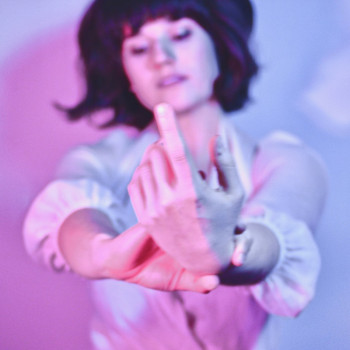Girl Blue’s dreamy and poignant “Lolita” decries the way young girls grow up as the object of cultural obsession.
— —
“I was every single girl, I was nobody else, I was so sure of myself.” So says the 15-year-old memory of Girl Blue‘s Arielle O’Keefe, who was “standing around like one of those girls” in the movies. “Lolita,” the lead single off the Albany-based singer/songwriter’s debut album, decries the way young girls grow up as the object of cultural obsession.
I was standing on my best friend’s balcony
feeling a certain kind of wise at seventeen
thinking the flare on the lens was the real thing.
She was with her boyfriend in the back room
I was chain-smoking cigarettes
and looking at the moon,
Thought I was really in it, I didn’t really get it.
Listen: “Lolita” – Girl Blue
[soundcloud url=”https://api.soundcloud.com/tracks/412542885?secret_token=s-snyGU” params=”color=ff5500&auto_play=true&hide_related=false&show_comments=true&show_user=true&show_reposts=false” width=”100%” height=”166″ iframe=”true” /]Atwood Magazine is proud to be premiering Girl Blue’s dreamy and poignant single. Using Nabokov’s Lolita as a thematic centerpiece, O’Keefe traverses a both deeply personal and universal account of the dichotomy the world presents to young girls – one that expects both innocence and worldliness. She explains the song as a chronicle of “how it feels to grow up as a female in a culture obsessed with young women and their sexuality.”

The song begins with a popped snare and we’re dropped into an mid-tempo synth line, punctuated by drums and bass. Musically, it is vaguely reminiscent of SBTRKT’s “Wildfire.” O’Keefe’s smooth voice enters and begins narrating a version of herself from the past.
I was standing around like
one of those girls I had seen in a movie
The whole world was a movie back then
I had my sunglasses on,
I wanted to be seen without seeing,
Shy Lolita,
I wasn’t really in it, I didn’t really get it.
O’Keefe deftly explains the feeling of unreality that often accompanies adolescence, saying in the bridge that she “lost her cool” and “sweet melting little girl dreams.” This beginning of this loss of innocence is one experienced by so many girls in the ages between childhood and adolescence. But the knowledge of this loss is clouded by the remainder of childhood. As she states that “the whole world was a movie,” the song becomes cinematic. It’s easy to envision a 15-year old O’Keefe standing with her sunglasses on, and later, on the balcony “looking at the moon.” These images are all filtered through the hazy pastel of the song, which begins to become dreamlike. Her vocal is subtle and beautiful, full of nuance and ache. At the chorus, her voice opens up and the listener is treated to a glossy 80s-pop soundscape with the true crux of the song:
I want a big life, not a how sad coulda been life
Where are you taking me, where are you taking me?
Said, everything I do I feel farther removed from my old life
Where is it taking me, where is it taking me?
The song, sung from a current perspective, rummages through memories and moments, trying to make sense of a life. The feeling of “Where is it taking me?” can become a pervasive one. In the second verse, O’Keefe recounts a 17-year-old memory, where she felt “a certain kind of wise.” In the repetition of “I wasn’t really in it, I didn’t really get it,” we feel the speaker’s uncertainty at her place in the world. At the last pre-chorus, she states:
And I lost my cool somewhere around the bend
It started making less sense
Holding onto all that innocence
The last revelatory moment comes on the bridge, where O’Keefe’s mother tells her to “Stay young,” and she “comes undone.” It goes out on the chorus, where O’Keefe triumphantly repeats, “Where is it taking me?” This time, it feels a little more optimistic. Sonically, the song becomes big, bold, and vibrant. O’Keefe’s gorgeous vibrato soars in ad libs and harmonies, while colorful synth lines float around her. The song produces a kind of nostalgia that is bittersweet. The negativity accompanying the things expected from young girls is present, but there is hope for something better, something positive to make from the memories. Simple as it may be to point out, the song ends in a major key. The listener feels uplifted by the end, and hopes along with O’Keefe. It’s a beautiful song that encapsulates girlhood in a way that is felt by many. Stay on the lookout for Girl Blue’s debut album, sure to be just as enchanting.
— — — —

Connect to Girl Blue on
Facebook, Twitter, Instagram
Discover new music on Atwood Magazine
? © AntiFragile Music









